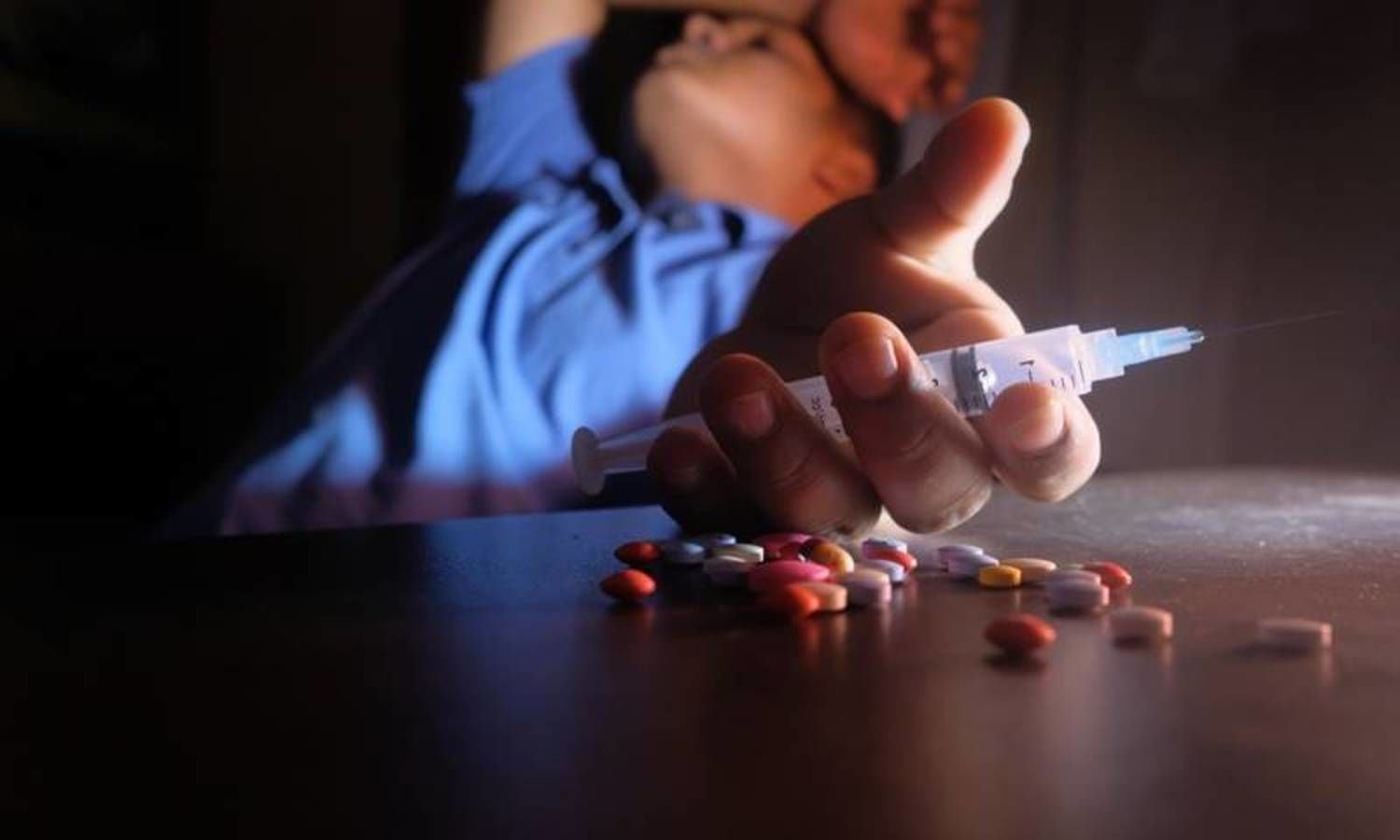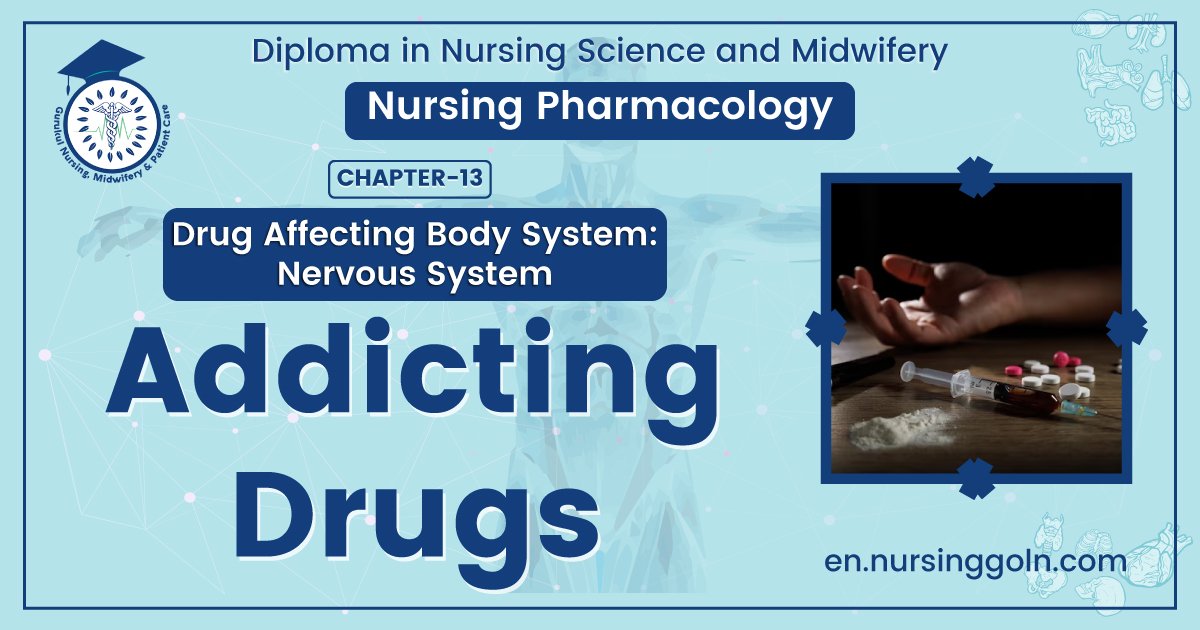Addicting Drugs – This book covers the entire syllabus of “Pharmacology” prescribed by BNMC- for diploma in nursing science & midwifery students. We tried to accommodate the latest information and topics. This book is an examination setup according to the teachers’ lectures and examination questions.
At the end of the book, previous questions are given. We hope in touch with the book students’ knowledge will be upgraded and flourish. The unique way of presentation may make your reading of the book a pleasurable experience.

Addicting Drugs
Drugs that produce addiction, are called addicting drugs.
1. High addiction potential and no medical use: Hallucinogenic agents:
- Heroine
- Cocaine
- Marijuana
2. High addiction potential with medical use:
- Morphine and other opioid analgesics.
- Amphetamine.
3. Moderate addiction potentiality: Barbiturates.
4. Low addiction potentiality: Benzodiazepines.
Management of morphine addict patient:
1. The treatment of morphine addiction is usually towards helping the addict to live without drugs
2. The withdrawn of addicting drugs is a gradual process (maintenance treatment of addiction).
3. Methadone is a drug of choice in the treatment of morphine addict patient (methadone shows cross- tolerance with morphine. The withdrawal effects of morphine are reduced by administration of methadone).
4. Replacement of morphine with methadone can be brought about by two ways:
a. Complete withdrawn of morphine and calculated dose of methadone is given. The dose of methadone is given. The dose of methadone then gradually reduced over a period of about a week.
b. Tapering procedure: morphine is gradually reduced and methadone is given in the doses, to replace the withdrawn drug.
5. In this way morphine is completely replaced by methadole and the methadone is withdrawn as before.
6. Psychological support to the patient.
7. Social rehabilitation.

Gout
Gout is a genetically determined metabolic disease characterized by recurrent episodes of acute arthritis due to deposition of crystals of monosodium urate in the synovial tissue of joints
➤ Level of uric acid
Normal: In male- 1200 mg
In female: 600 mg.
In Gout it may increase up-to 5-26 times of normal.
➤ Mechanism of Gout
Gout can be considered a disorder of metabolism that allows uric acid or urate to accumulate in blood and tissues. When tissues become supersaturated, the urate salts precipitate, forming crystals. In addition, the crystals also are less soluble under acid conditions and at low temperatures, such as occur in cool, peripheral joints (e.g. the metatarsophalangeal joint of the big toe). Causes of Gout
A. Under-excretion of uric acid: it is due to –
1. Primary renal abnormality
2. Drugs:
✓ Low dose of aspirin
✓ All diuretics except spironolactone
✓ Pyrazinamide
✓ Nicotinic acid
✓ Ethambutol
✓ Alcohol
B. Over production of uric acid:
✓ Increase purine biosynthesis due to enzyme defect. To selges
✓ Treatment of myeloproliferative & lymphoproliferative disorder by anticancer drugs

Drugs used to treat gout (act in the following ways)
1. To suppress the symptoms: Indomethacin, Colchicinc.
2. To prevent urate synthesis: Allopurinolimat
3. To promote elimination of urate (uricosurics): Probenecid
Indomethacin:
1. Drug of choice in acute gout.
2. Dose: 50 mg t.d.s (a cap: 25 mg)
3. Produce substantial relief within 24-48 hours.
4. Attack should resolve within a few weeks. (azapropazone. Diclofenac, Naproxane: used in acute attack).
Allopurinol
Allopurinol is a “xanthine oxidase inhibitor (xanthine oxidase converts xanthine and hypoxanthine to uric acid).
1. Absorption: Readily absorbed from gut
2. Plasma half-life: 2 hours
3. Metabolism: Liver (alloxanthine)
4. Excretion: Kidney.
Indication of allopurinol
1. Frequent acute attacks of gout.
2. Chronic gouty arthritis or tophi
3. Renal stones
4. Very high serum uric acid level (>9 mg/dl).
5. Prophylaxis when treating malignant disease.
Adverse effects of allopurinol
1. Precipitation of acute gout.
2. Allergic reaction (leucopenia, skin rash)
3. Gut upset.
Dose: Single daily dose: 300 mg. (in renal failure 100 mg daily)
Uricosuric Agents
Uricosuric agents are the drugs that increase the urate excretion in the urine. Uricosuric agents are
1. Probenecid
2. Sulfinpyrazone.

Probenecid
1. It is uricosuric agent.
2. Route of administration: orally.
3. Antagonist: Aspirin.
4. Probenecid inhibits tubular reabsorption and secretion of organic anions.man
5. Inhibits the urate reabsorption from the kidney tubules (increase excretion).alfalt t
6. Inhibits the tubular secretion of penicillin. Therefore it maintained high plasma penicillin concentration.
7. Indication: Chronic gout (to prolong the effect of penicillin)
8. Adverse effects: GIT upset, skin rash, exfoliative dermatitis, aplastic anaemia, nephrotic syndrome.
9. Dose: 0.5 mg orally daily in divided dose and progressing up-to 1 gm daily, after one week. Psychotrophic drugs (Psychoactive or Phenoactive Drugs) Drugs that inhibit, sharpen or alter the emotional & behavioral response are called psychotropic drugs (or. psychoactive drugs)
Read more:
